Written By Josh Koplin Consider this scenario: You’re online shopping, hopping from one site to another, comparing products and prices. You find a product you like, but there’s no price listed. How likely are you to reach out to the company for more information? If you’re like most consumers, you’re not going to waste your Read more
Industry Blogs

Written By Josh Koplin
Consider this scenario: You’re online shopping, hopping from one site to another, comparing products and prices. You find a product you like, but there’s no price listed. How likely are you to reach out to the company for more information? If you’re like most consumers, you’re not going to waste your time; you’ll just move on to a site that gives you what you need.
In today’s digital-first world, the business landscape, particularly within the HVAC industry, has dramatically evolved. Transparent and efficient online quoting is now crucial because it directly influences homeowners’ decisions. Reducing barriers to contact and providing clear, transparent information are essential for building trust with customers and preventing them from turning away to seek other options.
Shifting Homeowner Demographics
This shift can be traced back to our increasingly digital lifestyle as well as changing homeowner demographics. According to the National Association of Realtors, millennials currently constitute the largest share of home buyers at 38%, followed by Gen X at 24%. Additionally, The Builders Daily reports that Gen Z accounted for 15% of first-time homebuyer mortgage applications in 2023, a figure that is expected to rise. These younger, digital-native generations demand quick and accurate information, especially when making significant decisions like home investments.
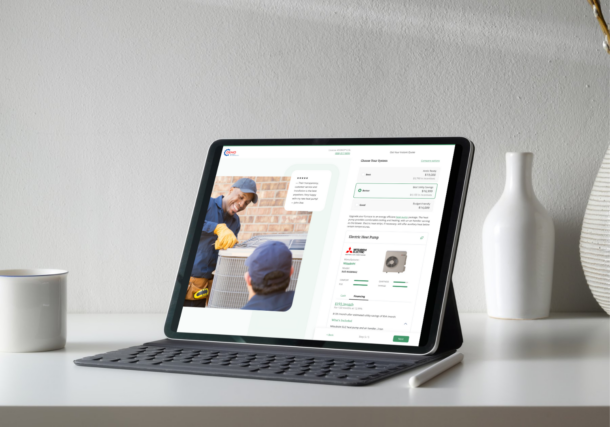
Building Trust Through Transparency
Marcus Sheridan’s exploration of consumer psychology in “They Ask You Answer” provides a stark reminder of the importance of transparency in pricing.
“The absence of price information doesn’t just inconvenience potential buyers; it actively drives them away,” Sheridan wrote in his book. “The modern consumer doesn’t just give up; they move on to someone who will meet their needs for information transparency.”
This perspective is especially relevant in the HVAC industry, where decisions are both infrequent and significant, making the stakes of transparency even higher.
Reflecting this, a recent survey from Clear Seas Research and The ACHR NEWS reveals a compelling trend: 71% of all homeowners express a preference for transparent online pricing and the figure jumps to 100% among Gen X and younger demographics. This data not only emphasizes the importance of clear pricing but also signals a shift towards greater consumer empowerment and expectation, challenging HVAC companies to adapt swiftly or risk losing out to more transparent competitors.
The Critical Role of Speed in Service
The concept of ‘speed to lead’ emphasizes the importance of quick responses to customer inquiries, which is vital in the HVAC industry. Equally crucial is the ‘speed to quote’, especially for younger generations who are accustomed to immediate gratification. The relationship between quick quote delivery and customer satisfaction is clear, particularly in industries like HVAC where timely decision-making is crucial. Speedy responses to quote requests reflect a company’s efficiency and responsiveness, qualities highly valued by today’s consumers.

Strategies for Fast, Accurate Quotes and Instant Gratification
Shifting homeowner demands and evolving demographics necessitate a strategic adaptation by HVAC contractors. This requires not only the implementation of best practices such as training customer service representatives and integrating digital tools like CRMs, texting platforms, but also new and innovative online sales tools. The ‘speed to quote’ race begins as soon as a potential customer lands on a contractor’s website, and using new online sales tools allows contractors to capture these potential customers and convert them into closed sales.
Adopting these new technologies not only meets the growing expectations for transparency, speed, and convenience but also ensures that contractors are aligned with the needs of Gen X, Millennial and Gen Z homeowners. By streamlining the quoting process and maintaining a focus on transparency, HVAC companies can significantly enhance their market appeal and meet the demands of a new generation that prioritizes quick, clear, and efficient service.
 Josh Koplin is a co-founder of EDEN, a Seattle-based startup with a mission to empower contractors with innovative technology, helping them to grow their businesses and provide exceptional customer experiences. Founded in 2021, EDEN provides a digital sales enablement tool to help HVAC contractors provide quick and accurate instant quotes for HVAC systems. By leveraging technology to provide prices and detailed breakdowns of eligible incentives and expected utility savings online, EDEN helps promote high-efficiency systems that contribute to sustainability and benefits both homeowners and contractors. For more information, visit https://www.e-denhomes.com/.
Josh Koplin is a co-founder of EDEN, a Seattle-based startup with a mission to empower contractors with innovative technology, helping them to grow their businesses and provide exceptional customer experiences. Founded in 2021, EDEN provides a digital sales enablement tool to help HVAC contractors provide quick and accurate instant quotes for HVAC systems. By leveraging technology to provide prices and detailed breakdowns of eligible incentives and expected utility savings online, EDEN helps promote high-efficiency systems that contribute to sustainability and benefits both homeowners and contractors. For more information, visit https://www.e-denhomes.com/.
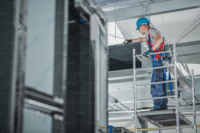
Sustainability in building systems has become a trending topic in the past several years. Although equipment with a higher level of efficiency and overall sustainability tends to cost more to produce and install, interest continues to grow. Property owners want the assurance of knowing that their systems can handle changes in the availability of energy Read more
Sustainability in building systems has become a trending topic in the past several years. Although equipment with a higher level of efficiency and overall sustainability tends to cost more to produce and install, interest continues to grow. Property owners want the assurance of knowing that their systems can handle changes in the availability of energy and interruptions to the power grid, while still providing excellent indoor comfort. These trends highlight the ongoing development of sustainable HVAC technology for residential, commercial and industrial customers.
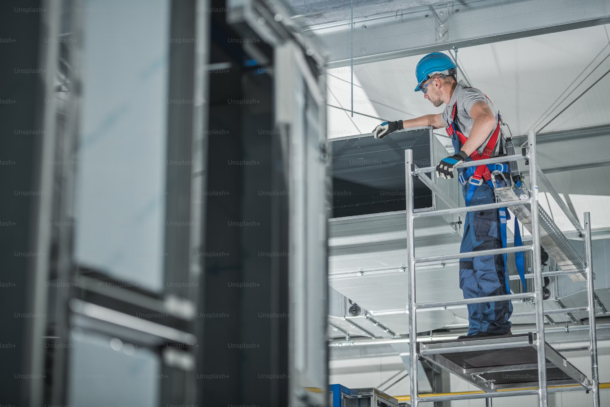
Efficient HVAC Systems
A push toward greater efficiency makes sense in terms of sustainability and lower carbon emissions. Efficient systems, with proper installation and routine maintenance, can significantly reduce the energy consumption for the same amount of cooling or heating output. To accommodate the need for more effective HVAC systems, the U.S. Department of Energy set new standards in 2023 for the minimum efficiency of certain types of HVAC equipment. New systems with cooling capability must meet a minimum seasonal energy efficiency ratio of 14 or 15, depending on region. Heat pumps must also follow a minimum heating seasonal performance factor of 8.8.
Sustainable Energy Sources
As worry about the availability of fossil fuels increases, manufacturers look for ways to decrease their dependence on these fuels. In the past decade, technological advances allowed consumers and businesses to implement sustainable HVAC solutions, such as geothermal heat pumps. Innovation continues as the market adds and refines options. Hydronic systems rely on systems of water to extract heat for indoor heating, water heating, and other purposes, conserving the water for use. Solar thermal systems allow for the large-scale production of electricity — enough for applications in residential, commercial and industrial sectors.
Tools to Improve Indoor Air Quality
Ventilation is one of the most important aspects of heating and cooling systems, and recent advancements can make ventilation easier and more effective. The COVID-19 pandemic and the rise in the number of wildfires highlighted the importance of indoor air quality, which is often worse than the air outside. New systems can accommodate a variety of additional features, including UV bulbs, antimicrobial air filters and other types of air purification systems. HVAC technicians installing a series of these air cleaning options can help to improve the indoor air quality without compromising air flow or efficiency.
Smart Technology
Smart technology allows residences and businesses to maximize comfort while working on decreasing energy consumption and improving energy efficiency. Automated systems simplify the process of managing a commercial building, with the ability to seamlessly integrate HVAC into lighting, security, and other systems. Smart technology continues to improve in ways that decrease the need for human attention. Advanced sensors can help users monitor the temperature, humidity and air quality of various parts of the building, as well as locating problems and identifying the best times for heating and cooling maintenance.
Self-Cleaning HVAC Systems
Although professional maintenance twice a year offers the best case for long-term equipment efficiency, the time between those visits can wreak havoc on a system. Dirty equipment leads to lower efficiency, drops in performance and system breakdowns. The latest technology incorporates some elements of self-maintenance, so that users can provide ideal protection for their systems between maintenance services. For example, HVAC systems need to be kept clean and dry for proper operation. A self-cleaning function for an air conditioning unit might focus on drying each component, to prevent water buildup, icing and dust accumulation.
The rising cost of fuel, coupled with potential interruptions to the power grid, turns people’s heads to the possibilities of renewable energy technology. New HVAC systems can rely on heat and energy sources that allow property owners to minimize their dependence on fossil fuels or an overworked power grid. These technologies provide other benefits, including decreasing energy consumption, lowering carbon emissions and improving indoor air quality.
 Author bio: Leslie Erickson is the Marketing Manager at Air Mechanical. She has been working for Air Mechanical for most of her life and specializes in marketing. She is dedicated to bringing customers the best experience possible for their family and their homes.
Author bio: Leslie Erickson is the Marketing Manager at Air Mechanical. She has been working for Air Mechanical for most of her life and specializes in marketing. She is dedicated to bringing customers the best experience possible for their family and their homes.
SOURCES
https://www.eia.gov/todayinenergy/detail.php?id=40232
Sustainable HVAC Trends: What Clients are Asking for in 2024
Smart Tech & Innovations for Sustainability in the Future of HVAC
https://www.grainger.com/know-how/operations/facility/kh-hvac-evolving-for-sustainability
https://www.eia.gov/todayinenergy/detail.php?id=40232

By Heather Ripley As a local home service business owner, you no doubt value having a lot of positive online reviews. But, outside of some kind words from customers on Google or Yelp, is your local reputation positive? Does it reflect what you consider your company’s brand values? Your reputation influences the public’s perception of Read more
By Heather Ripley
As a local home service business owner, you no doubt value having a lot of positive online reviews.
But, outside of some kind words from customers on Google or Yelp, is your local reputation positive? Does it reflect what you consider your company’s brand values?
Your reputation influences the public’s perception of your company, and every business has one. The trick is to ensure that your employees and other company representatives know your company’s core values and what it means to live by them every day.

Perception Versus Reality
When you first started your plumbing company, chances are your business consisted of you, a helper and a truck.
During those early days, it may have been difficult to find the time to chart your vision and create a business plan so that you could scale your growth. But as you grew, you had to take the time to build a game plan that would help you work on your business and not just in it.
At this point in your business development, you began to list and define your company’s core values. Your goal was to embed these values into your company’s standards, norms, processes and behaviors.
Developing a clear mission statement and a consistent brand voice are key to boosting your reputation. Not only does it help your employees understand your vision for the future, it also gives you something to measure your capabilities against.
You may believe that quality service and commitment to community are two of your top five values, for example. But unless you are regularly monitoring your online reviews, surveying your customers and educating your employees on what sets you apart from your competition, your perception of your company’s standing might not be the reality.
Find Out Who You Are
Recent studies have shown that as many as 92% of consumers read online reviews before deciding to do business with a company. If sales are faltering or you’re not meeting customer needs, it might be time to investigate the disconnect between what you think your reputation is and how others see you.
Here are a few steps to take:
- Track your social media. Take a look at what customers are saying on your posts or see if they are saying anything at all. If you have a lot of complaints on Facebook or your marketing department’s posts aren’t aligned with your vision, it may be time to retrain your employees on your key values.
- Read your online reviews. Most home service companies understand how important online reviews are to the growth of a company. You may have instructed your team to ask for positive reviews, but if they aren’t following up to ensure complaints are answered, you’re opening your company up as a target for trolling behavior.
- Get involved in your community. If you volunteer for local events or sit on the board of an area nonprofit organization, you’ll have the opportunity to meet new people and get a first-hand look at how others perceive you.
If what you read, see and hear doesn’t match up with what you expect your reputation to be, you may need to concentrate on some reconstructive training and reputation management.
Build a Winning Reputation
Once you’ve determined where you stand in the community, you may need to either repair any damage in the worst-case scenario or simply build up your reputation in the best scenario.
To do this, you might need to do two things: retrain your employees to better represent your brand values and hire a reputable public relations agency that can help you get your message out to the general public.
Training your employees to embody your company’s values and brand identity should be a part of your onboarding process, but it never hurts to have refresher courses. But when it comes to boosting your positive reputation among the community, a PR professional is the expert at building relationships and telling your story.
Virgin Group founder Richard Branson once said, “Your brand is only as good as your reputation,” and ensuring that your local reputation reflects your brand values is a must in the home services industry. Customers have to trust the skilled trades technicians that come into their homes, so if your reputation is suffering in the community, you will lose business.
Don’t leave this to chance. Stay on top of your reputation management. It’s just a part of doing business in today’s connected world.
 Heather Ripley is founder and CEO of Ripley PR, an elite, global public relations agency specializing in the skilled trades, franchising and B2B tech industries. Ripley PR is recognized as the top PR agency for the home service industry. It also has been listed by Entrepreneur Magazine as a Top Franchise PR Agency for six consecutive years and was recently named as one of Newsweek’s America’s Best Public Relations Agencies for 2024. Heather Ripley was recently named as a 2024 PRNews Top Women honoree in the business entrepreneur category. She is also the author of “NEXT LEVEL NOW: PR Secrets to Drive Explosive Growth for your Home Service Business,” which is now available on all audiobook platforms. For additional information, visit www.ripleypr.com.
Heather Ripley is founder and CEO of Ripley PR, an elite, global public relations agency specializing in the skilled trades, franchising and B2B tech industries. Ripley PR is recognized as the top PR agency for the home service industry. It also has been listed by Entrepreneur Magazine as a Top Franchise PR Agency for six consecutive years and was recently named as one of Newsweek’s America’s Best Public Relations Agencies for 2024. Heather Ripley was recently named as a 2024 PRNews Top Women honoree in the business entrepreneur category. She is also the author of “NEXT LEVEL NOW: PR Secrets to Drive Explosive Growth for your Home Service Business,” which is now available on all audiobook platforms. For additional information, visit www.ripleypr.com.

Home generator technology has evolved significantly over the past few years, and the next decade promises even more exciting advancements. As trades professionals, staying informed about these trends is crucial to offering the best solutions to clients. Here, we explore the upcoming innovations that will shape the future of home generators. These include integrated solar Read more
Home generator technology has evolved significantly over the past few years, and the next decade promises even more exciting advancements. As trades professionals, staying informed about these trends is crucial to offering the best solutions to clients. Here, we explore the upcoming innovations that will shape the future of home generators. These include integrated solar power and battery storage, increased efficiency with cleaner fuel options, and the growing role of artificial intelligence (AI) in optimizing performance and maintenance.
Integrated Solar Power and Battery Storage
One of the most significant trends expected in the whole house generator market is the integration of solar power and battery storage systems. As the world shifts towards renewable energy sources, the demand for sustainable and efficient power solutions is increasing. Future home generators are likely to incorporate solar panels and advanced battery storage technologies. Homeowners will be able to harness and store solar energy for use during power outages.
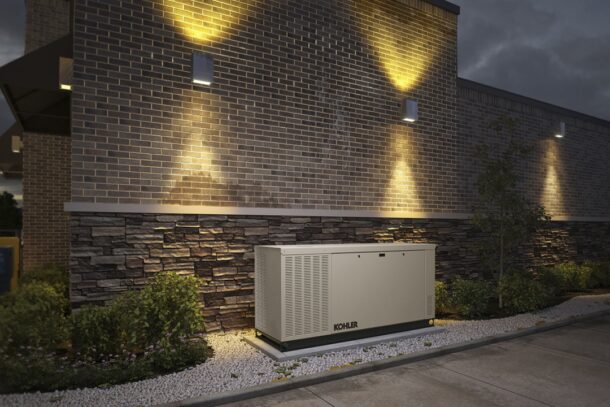
Benefits of Solar Integration
- Reduced Reliance on Fossil Fuels: Integrating solar power can significantly reduce the need for traditional fuel sources, making generators more eco-friendly.
- Cost Savings: Solar energy can lower operational costs over time, providing homeowners with a more economical power solution.
- Energy Independence: Homeowners can become less dependent on the grid, ensuring a reliable power supply during outages.
Increased Efficiency and Cleaner Fuel Options
Another critical advancement in home generator technology will be the focus on increased efficiency and the use of cleaner fuel options. Traditional generators often rely on diesel or gasoline, which can be expensive and harmful to the environment. However, the next decade is expected to bring generators that are more efficient and capable of running on alternative fuels.
Emerging Fuel Options
- Natural Gas: Generators powered by natural gas are becoming more popular due to their lower emissions and cost-effectiveness.
- Propane: Propane is another clean-burning alternative that offers long shelf life and reduced environmental impact.
- Biogas: Produced from organic waste, biogas is a renewable fuel source that can help reduce greenhouse gas emissions.
The Role of Artificial Intelligence
Artificial intelligence is set to revolutionize home generator technology by enhancing performance, efficiency, and maintenance. AI algorithms can analyze data from various sources to predict potential issues and optimize generator operations. This technology can provide real-time insights and automate maintenance schedules, reducing the likelihood of unexpected breakdowns.
AI Applications in Generators
- Predictive Maintenance: AI can monitor generator performance and predict when maintenance is needed, preventing costly repairs and downtime.
- Energy Management: AI systems can optimize the use of stored energy, ensuring that power is available when needed most.
- Remote Monitoring: Homeowners can monitor and control their generators remotely through AI-powered apps, enhancing convenience and peace of mind.
Smart Home Integration
The future of home generators will also see greater integration with smart home systems. This means generators will be able to communicate with other smart devices in the home, providing seamless and automated power management. For instance, a smart generator could automatically start when it detects a power outage and send alerts to the homeowner’s smartphone.
Advantages of Smart Integration
- Enhanced Control: Homeowners can have greater control over their power systems through smart home interfaces.
- Improved Efficiency: Smart systems can optimize power usage, reducing waste and improving overall efficiency.
- Convenience: Automated operations and real-time notifications make managing power supply easier and more convenient.
The next decade promises significant advancements in home generator technology, driven by the integration of renewable energy sources, cleaner fuel options, and artificial intelligence. For trades professionals, understanding these trends is essential to staying ahead in the industry and providing clients with the most advanced and efficient power solutions. By embracing these innovations, tradesmen and women can help homeowners achieve greater energy independence, cost savings, and environmental sustainability.
As the technology evolves, staying informed and adaptable will be key to leveraging the full potential of these advancements in home generators.
 Joel Scott Bennett is Director at Canter Power of Mark Systems, a leading residential generator installer. Bennett is trained as an industrial designer, empathetic and personable, he leads the creation of business opportunities through the fast-changing energy sector.
Joel Scott Bennett is Director at Canter Power of Mark Systems, a leading residential generator installer. Bennett is trained as an industrial designer, empathetic and personable, he leads the creation of business opportunities through the fast-changing energy sector.
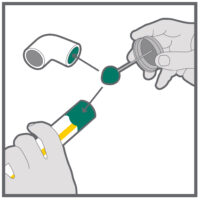
By Jonathan Simon The 2024 plumbing and mechanical codes contain a subtle but significant change all plumbers should know. For the first time, green-colored solvent cement has been approved into the model codes for use with copper-tube size CPVC. Here’s how that change came about and what it means to plumbing contractors. The Need for Read more
By Jonathan Simon
The 2024 plumbing and mechanical codes contain a subtle but significant change all plumbers should know. For the first time, green-colored solvent cement has been approved into the model codes for use with copper-tube size CPVC. Here’s how that change came about and what it means to plumbing contractors.
The Need for Change
Plumbers who work with CPVC appreciate its ease of installation, reliability, and the straight, professional appearance that showcases the plumber’s craftsmanship. But in recent years, plumbers have become increasingly concerned with the risk of dry-fit failures that occur when a joint is not properly solvent welded. The team behind FlowGuard Gold CPVC received feedback from plumbers that the lack of contrast between the yellow cement and the tan pipe could make it difficult to see the solvent cement when visually inspecting installations.
That’s important because CPVC pipes and fittings have an interference fit in which the fitting socket is tapered, so the outer diameter of the pipe is slightly larger than the inside diameter at the bottom of the fitting. When solvent cement is applied and the pipe is bottomed out in the fitting, the two components are fused into a single piece of CPVC and create a joint that is extremely strong and reliable.
But with a tight interference fit, a dry joint can still be strong enough to withstand a pressure test without being solvent welded. Because of this extreme joint strength, even an unwelded CPVC joint can hold for a long time under everyday operating conditions, but eventually natural movement and stress on the system will cause an unwelded joint to fail. These dry-fit installation errors are extremely rare but can be very frustrating.

Eliminating Dry Fit Errors
There are two steps plumbers can take to eliminate dry-fit errors. One is to weld each joint as it is assembled. This helps ensure every joint is solvent welded and has the added benefit of enabling faster, more efficient installation than pre-assembling the entire system and then coming back through with solvent cement.
The other is to visually inspect the system after installation to ensure solvent cement is visible around each joint. Visual inspection is a critical step in any piping installation process, so when contractors told us that visual inspection was more challenging than it could be due to the color of the cement, we began exploring solutions.
Because the plumbing and mechanical codes required that one-step solvent cement be yellow in color, FlowGuard Gold first worked with our solvent cement partners to develop a cement that includes a UV indicator. This allows the contractor or installer to verify solvent welded joints using a UV flashlight. This solution proved effective, but we recognized there was an opportunity to make the process even easier for plumbers.
Changing the Plumbing Code
In 2020, we asked our solvent cement partners to support the manufacture of a new color solvent cement that would provide high contrast when used with FlowGuard Gold pipe and fittings and they agreed. By listening to the voice of plumbing and mechanical contractors across the country, we identified the color green as the ideal solution for a high contrast CPVC solvent cement.
The next step was to get code approval for the green-colored cement. We developed and presented a proposal to the leading code organizations requesting that the green-colored cement be approved as an alternative to yellow for copper-tube size CPVC. Because the color change did not impact the installation process or the performance of the cement, the proposal met no resistance in technical committees or in the public comment stage of the process.
The proposals were approved in 2023 and high-contrast green solvent cement is now included in the 2024 International Plumbing Code, section 605.14.2; the International Mechanical Code, section 1203.3.4; the Uniform Plumbing Code, section 605.2.2; and the Uniform Mechanical Code, section 1211.3.2.

A Welcome Addition
Because our solvent cement partners were involved in the process from the beginning, they were prepared to bring green-colored, one-step solvent cement to market as soon as the proposed changes were underway. Simultaneously, the team communicated with state, county and local code officials across the U.S. informing them of the pending change and the reason behind it so they could feel confident approving installations using the high-contrast cement in the period between when the changes were approved and published.
These steps allowed contractors, with approval from the appropriate official, to begin using the green-colored cement as early as 2021. Feedback from early adopters was uniformly positive. A number of contractors transitioned to high-contrast green solvent cement for all their projects before the new codes were even published and use of the green-colored solvent cement continues to build momentum in the market.
Even though green-colored cement is now included in the published 2024 codes, it is recommended that contractors verify local codes and approvals prior to installation and always follow the manufacturer approved instructions.
A Small Addition with Big Benefits
Plumbing contractors working with CPVC now have three choices in manufacturer-authorized and code-approved FlowGuard solvent cement: traditional yellow, yellow with UV indicators, and high-contrast green. While the addition of green-colored cement represents a small addition to the FlowGuard Gold CPVC product family, it is a significant advancement giving contractors working with CPVC greater peace of mind and improved jobsite quality control. For more information on FlowGuard Gold CPVC, visit FlowGuardGold.com.
 Jonathan Simon is the North American residential plumbing manager for Lubrizol Advanced Materials Inc., the parent company for FlowGuard Gold Pipe and Fittings.
Jonathan Simon is the North American residential plumbing manager for Lubrizol Advanced Materials Inc., the parent company for FlowGuard Gold Pipe and Fittings.
